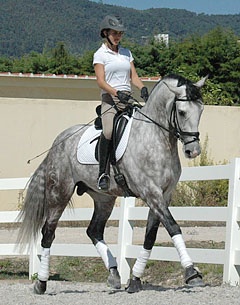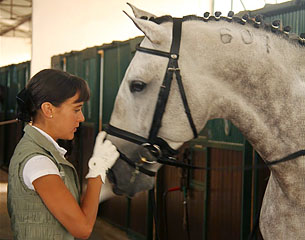
When a horse and rider are working in unison, the rider focuses his energy from his feet to the tip of his head on a vertical plane, one that corresponds with the flow of forward energy on the horse's horizontal plane.
However the horse's forward energy is then controlled, nurtured, motivated and fostered within a corridor, creating a rider's realm (of direct influence) from above, in front, behind, and at the sides of the horse.
"In early training we teach our horses to respond to bit pressures and the learning happens on the release. The horse learns that by responding it can cause the pressure to go away," said Dressage Technique expert Richard Weis. "It is called mouthing and is as effective in starting young horses as it is in re-organizing older horses."
Once training progresses and the horse learns the seat and leg aids, bit pressures become more subtle, until "it feels like the horse is encased in the aids, like it’s in a box. The back of the box are the driving aids, the front is the bit, the sides are the seat bones and legs. The horse is always in a defined corridor, not because it is held there, but because it learns the rules of staying inside the box.
Why else would a horse create such impulsion and lift? It’s because the rider allows the free flow of energy through the corridor, all the while maintaining his own stability, nurturing and encouraging the horse to give us his all! "A well educated horse will find ‘freedom’ inside the box. that’s the goal," says Richard.
To achieve this we must first establish an elastic connection to the horse's mouth, and then by using our seat, legs, and rein aids in sequence, we can help the horse learn to balance and carry us, control the power, yet release and allow him to balance himself, all at the same time.
"Putting the horse on the bit means: feeling that the poll flexes, the back rises, the haunches become active." N.Oliveira (1998, 42f.).
If you watch a truly brilliant horse and rider pair fly and dance across the arena, you realise this is not the way the horse trots around in the paddock by himself. And yet, he looks completely free. His energy is being harnessed and motivated by the rider's own freedom of seat, and the two unite in the centre to create that magic and power! The horse feels confident in the front, as the rider gently allows with the rein aid, but also gives power from behind, his back rising in response to the rider's seat and leg. However this sort of active freedom can only be achieved if the horse can find confidence in the rider's realm and is entirely dependent on the rider giving the aids without blocking or restricting the horse's power.
I watched a documentary once on a rider's reaction to a horse that got a fright. One rider pulled the reins, and then gripped with his legs, all in unison, as a defense reflex, hoping to smother the horse back into submission. This of course created a claustrophobic ball around the horse, the rider pushing with the leg and pulling with the rein simultaneously, forcing the horse to almost self-combust. The second rider, in response to the horse's shy, immediately released everything, loosened his legs, loosened his hips, loosened his reins and instead of gripping and tightening, put all his focus into staying completely balanced across the top of horse. This created like a protective sphere of confidence around the horse, allowing him to react, while gently waiting for him to return to the rider's realm. The rider was there, safely waiting around him, following his movement until the horse could relax back into his common ground (the corridor). To detect relaxation within the rider’s realm, some only look at the horse's mouth, when in truth a horse will only be truly relaxed if he is loose all the way through his body.
"The relaxation of the mouth alone is not enough. It can be deceptive, because it does not necessarily lead to lightness. It has to be accompanied by the relaxation of the entire horse. When he relaxes the back, it will definitely have repercussions in the mouth." N.Oliveira (1998, 43).
 A rider must be aware then, if the horse is not loose through the body, what the cause may be? And more often than not, it is the rider's inability to allow the energy to flow through the rider's realm and at some point is stopping or blocking the horse's natural energy. Tightening the hip? Holding on with the legs? Using leg and rein at the same time and thus trapping the horse? Instead the rider's movements must be fully articulated with the natural movements of the horse. Consider the walk halt.
A rider must be aware then, if the horse is not loose through the body, what the cause may be? And more often than not, it is the rider's inability to allow the energy to flow through the rider's realm and at some point is stopping or blocking the horse's natural energy. Tightening the hip? Holding on with the legs? Using leg and rein at the same time and thus trapping the horse? Instead the rider's movements must be fully articulated with the natural movements of the horse. Consider the walk halt.
"In the walk-halt transition, the box stops tactfully, but it’s still a box and the horse stops without bumping into it (front, back or sides), " said Richard. Why? Because the rider has made a forward transition and then released the rein. If the horse stops abruptly and onto the shoulders, the rider has blocked from within the rider's realm and possibly held the horse with the rein.
Picture the corridor with you in the centre and imagine that you are asking the horse for more impulsion, using the sides of the corridor (the leg aid) and the top (the seat). You must then allow at the front of the corridor or you will block the horse, trapping him and forcing him to feel trapped within the corridor. Imagine you are the horse and you are being squeezed at the sides, pulled at the front, where can you go? Alternatively if you are using your seat to ask for more impulsion from behind, you must again allow this energy to flow through the horse and out the front, releasing the front (the reins) and directing the horse through the walls of the corridor (the legs).
You may of course check and monitor the impulsion through the use of short takes and releases (half halts), but the minute you hold for too long, you block that impulsion, forcing the horse to lose his connection and fall onto the forehand, or alternatively you let the forward energy fly right out the back door.
To elasticize the corridor, the rider can use bending, as well as the alternate positioning of the hind quarters, to supple the horse (lateral work). Again the key point is to always allow the energy to continue its unhindered flow, from back to front. For example, if you have the horse in travers the energy flow from the back, flows up the corridor and if the rider is not careful will fly right out the outside shoulder. The rider must then focus his realm on maintaining a consistant outside connection, allowing the energy through the use of an open hip and inward turning shoulder to flow in a curve out the top of the horses head.
Always ask yourself, where is the power coming from, am I blocking it, or letting it escape, and if so, how can I better position myself to re-establish a rider's realm that allows the energy of the horse to move through his body and out the top of his ears? Once you can feel and adjust to that energy flow, you can create a rider's realm that governs and directs the horse, but does not restrict him.
"Don't play the master all the time. The difficulty is to feel to what extent one has to intervene." N.Oliveira (1998, 17).
And hopefully your horse will then find his own freedom from within!
by Sarah Warne for Eurodressage
Related Link
Sarah Warne's Classical Training articles